Small overlap front: driver-side
Rating applies to 2017-21 models built after December 2016
Tested vehicle: 2017 Jeep Compass Sport 4-door 4wd
The Jeep Compass was redesigned during the 2017 model year. (A short run of old-design 2017 models was produced through December 2016.) All 2017 and later Compass models built after December 2016 are the redesigned vehicles. (Information about when a specific vehicle was manufactured is on the certification label typically affixed to the car on the driver door or adjacent B-pillar.)
| Evaluation criteria | Rating |
|---|---|
| Structure and safety cage | |
| Driver injury measures | |
| Head/neck | |
| Chest | |
| Hip/thigh | |
| Lower leg/foot | |
| Driver restraints and dummy kinematics | |
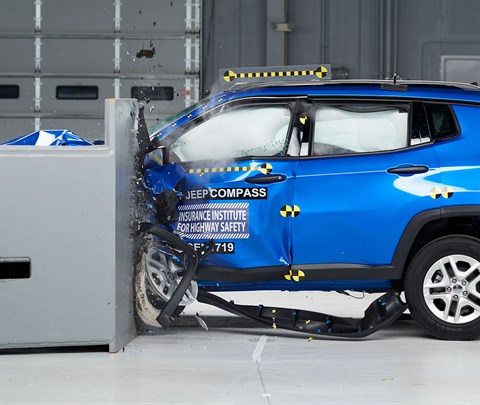
Action shot taken during the driver-side small overlap frontal crash test.

The dummy's position in relation to the door frame, steering wheel, and instrument panel after the crash test indicates that the driver's survival space was maintained very well.
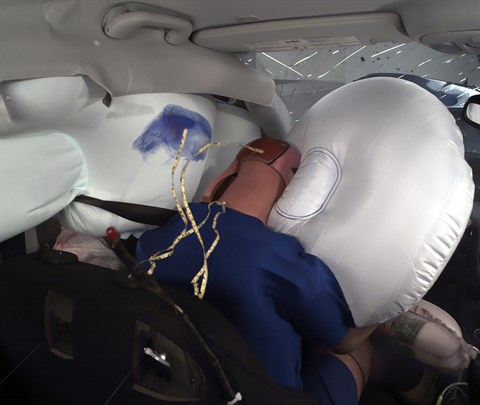
The frontal and side curtain airbags worked well together to keep the head from coming close to any stiff structure or outside objects that could cause injury.
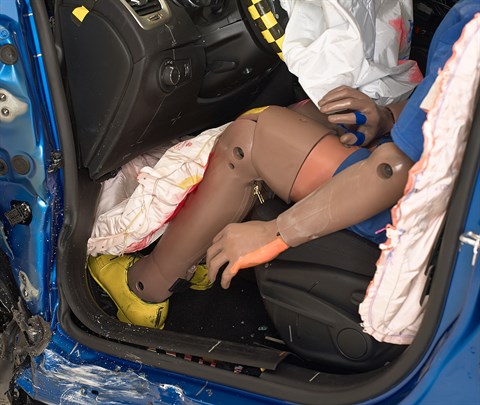
The driver's space was maintained well, and risk of injuries to the dummy's legs and feet was low.
Small overlap front: passenger-side
Rating applies to 2017-21 models built after December 2016
Tested vehicle: 2018 Jeep Compass Sport 4-door 4wd
The Jeep Compass was redesigned during the 2017 model year. (A short run of old-design 2017 models was produced through December 2016.) All 2017 and later Compass models built after December 2016 are the redesigned vehicles. (Information about when a specific vehicle was manufactured is on the certification label typically affixed to the car on the driver door or adjacent B-pillar.)
| Evaluation criteria | Rating |
|---|---|
| Overall evaluation | |
| Structure and safety cage | |
| Passenger injury measures | |
| Head/neck | |
| Chest | |
| Hip/thigh | |
| Lower leg/foot | |
| Passenger restraints and dummy kinematics | |
| Driver injury measures | |
| Head/neck | |
| Chest | |
| Hip/thigh | |
| Lower leg/foot | |
| Driver restraints and dummy kinematics | |
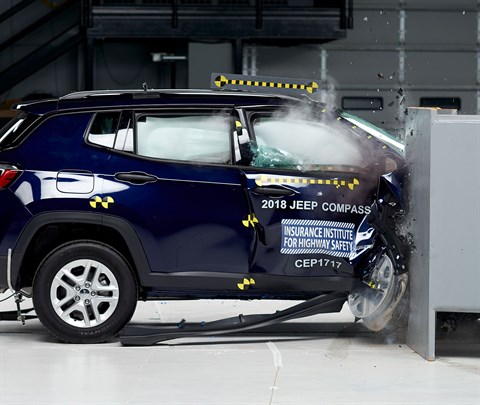
Action shot taken during the passenger-side small overlap frontal crash test.
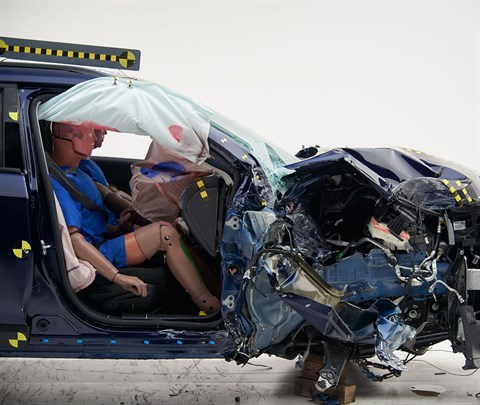
The dummy's position in relation to the door frame and dashboard after the crash test indicates that the passenger’s survival space was maintained reasonably well.

The frontal and side curtain airbags worked well together to keep the passenger dummy’s head from coming close to any stiff structure or outside objects that could cause injury.

Intrusion of the dashboard contributed to a moderate risk of injury to the right lower leg.
Moderate overlap front: original test
Rating applies to 2017-21 models built after December 2016
Tested vehicle: 2017 Jeep Compass Latitude 4-door 4wd
The Jeep Compass was redesigned during the 2017 model year. (A short run of old-design 2017 models was produced through December 2016.) All 2017 and later Compass models built after December 2016 are the redesigned vehicles. (Information about when a specific vehicle was manufactured is on the certification label typically affixed to the car on the driver door or adjacent B-pillar.)
Moderate overlap frontal ratings are assigned by the Institute based on a test conducted by Fiat Chrysler.
| Evaluation criteria | Rating |
|---|---|
| Overall evaluation | |
| Structure and safety cage | |
| Driver injury measures | |
| Head/neck | |
| Chest | |
| Leg/foot, left | |
| Leg/foot, right | |
| Driver restraints and dummy kinematics | |
Moderate overlap front: updated test
Rating applies to 2021 models
Tested vehicle: 2021 Jeep Compass Latitude 4-door 4wd
The Jeep Compass was redesigned during the 2017 model year. A short run of old-design 2017 models was produced through December 2016. All 2017 and later Compass models built after December 2016 are the redesigned vehicles. (Information about when a specific vehicle was manufactured is on the certification label typically affixed to the driver door or adjacent B-pillar.)
| Evaluation criteria | Rating |
|---|---|
| Overall evaluation | |
| Structure and safety cage | |
| Driver injury measures | |
| Head/neck | |
| Chest | |
| Thigh/hip | |
| Leg/foot | |
| Driver restraints and dummy kinematics | |
| Rear passenger injury measures | |
| Head/neck | |
| Chest | |
| Thigh | |
| Rear passenger restraints and dummy kinematics | |
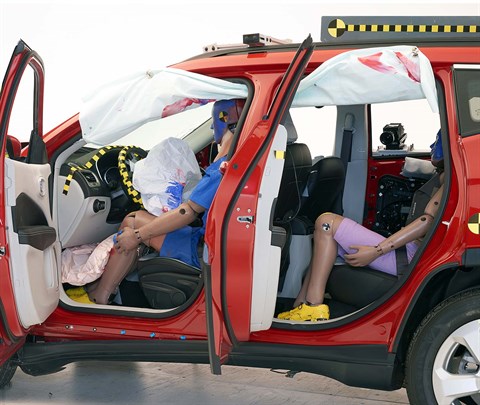
View of the vehicle after the crash showing the airbags and damage to the occupant compartment.
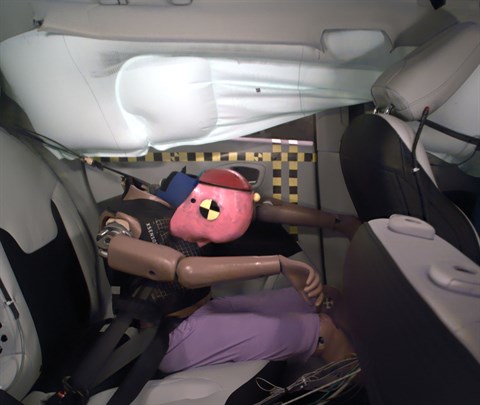
The rear passenger dummy's head remained a safe distance from the front seatback.
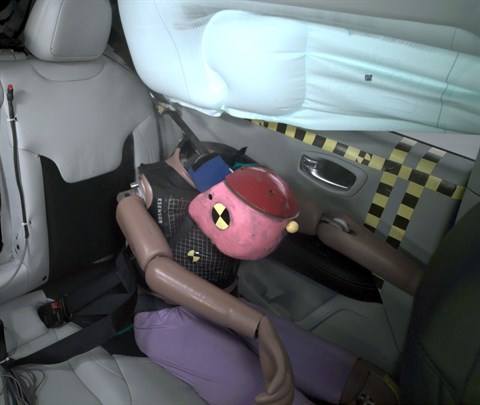
Rear passenger dummy injury values indicate a likely risk of injury to the head or neck and chest. During the crash, the shoulder belt remained in an ideal position on the dummy’s chest.
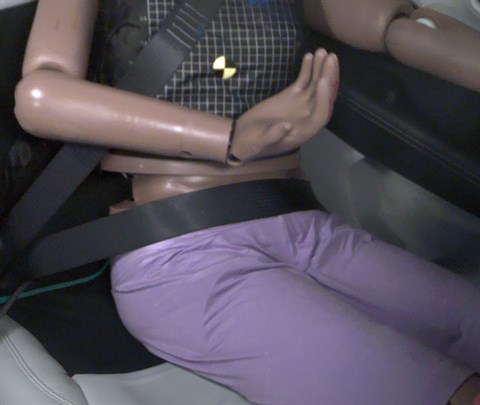
The rear passenger dummy's lap belt remained in the ideal position on the pelvis.
Side: original test
Rating applies to 2017-21 models built after December 2016
Tested vehicle: 2017 Jeep Compass Latitude 4-door 4wd
The Jeep Compass was redesigned during the 2017 model year. (A short run of old-design 2017 models was produced through December 2016.) All 2017 and later Compass models built after December 2016 are the redesigned vehicles. (Information about when a specific vehicle was manufactured is on the certification label typically affixed to the car on the driver door or adjacent B-pillar.)
Side ratings are assigned by the Institute based on a test conducted by Fiat Chrysler.
| Evaluation criteria | Rating |
|---|---|
| Overall evaluation | |
| Structure and safety cage | |
| Driver injury measures | |
| Head/neck | |
| Torso | |
| Pelvis/leg | |
| Driver head protection | |
| Rear passenger injury measures | |
| Head/neck | |
| Torso | |
| Pelvis/leg | |
| Rear passenger head protection | |
Side: updated test
Rating applies to 2017-21 models built after December 2016
Tested vehicle: 2021 Jeep Compass Latitude 4-door 4wd
The Jeep Compass was redesigned during the 2017 model year. (A short run of old-design 2017 models was produced through December 2016.) All 2017 and later Compass models built after December 2016 are the redesigned vehicles. (Information about when a specific vehicle was manufactured is on the certification label typically affixed to the car on the driver door or adjacent B-pillar.)
| Evaluation criteria | Rating |
|---|---|
| Overall evaluation | |
| Structure and safety cage | |
| Driver injury measures | |
| Head/neck | |
| Torso | |
| Pelvis | |
| Driver head protection | |
| Rear passenger injury measures | |
| Head/neck | |
| Torso | |
| Pelvis | |
| Rear passenger head protection | |
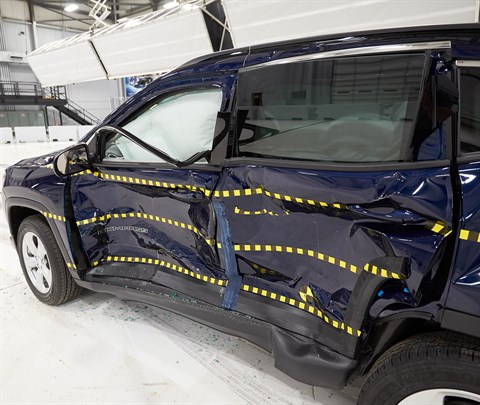
View of the vehicle just after the crash test.
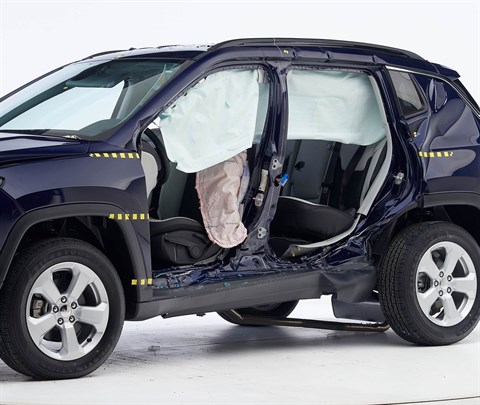
View of the vehicle after the crash with doors removed, showing the side airbags and damage to the occupant compartment.
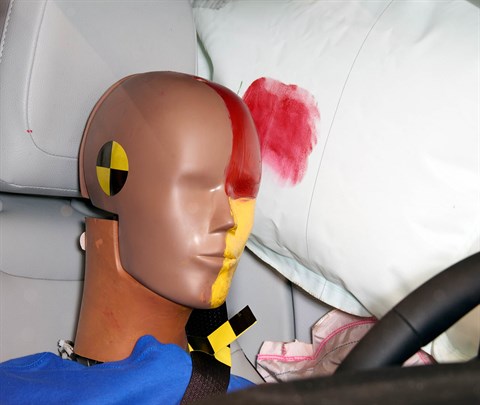
Smeared greasepaint shows where the driver dummy's head was protected from being hit by hard structures by the side airbags.
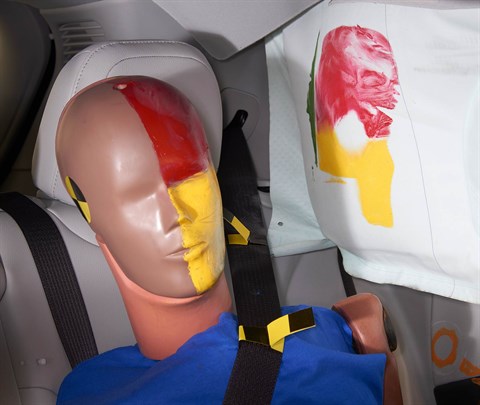
Smeared greasepaint shows where the rear passenger dummy’s head was protected by the side airbag.
Roof strength
Rating applies to 2017-23 models built after December 2016
Tested vehicle: 2017 Jeep Compass Latitude 4-door 4wd
| Overall evaluation | |
|---|---|
| Curb weight | 3,429 lbs |
| Peak force | 16,952 lbs |
| Strength-to-weight ratio | 4.94 |
Head restraints & seats
Seat type: Manual leatherette seat
| Overall evaluation | |
|---|---|
| Dynamic rating | |
| Seat/head restraint geometry |
About the head restraint & seat test
Currently, IIHS tests apply only to front seats.
Headlights
Ratings are given for 3 different headlight variations available on this vehicle.
Trim level(s)
- Limited trim equipped with Elite package
- Trailhawk trim equipped with Elite package
| Evaluation criteria | Rating |
|---|---|
| Low-beam headlight type | HID projector |
| High-beam headlight type | HID projector |
| Curve-adaptive? | No |
| High-beam assist? | Yes |
|
Overall rating | |
| Distance at which headlights provide at least 5 lux illumination: | |
Low beams
On the straightaway, visibility was fair on the left side of the road and inadequate on the right side. On curves, visibility was good on the gradual right curve, fair on the sharp right and sharp left curves, and inadequate on the gradual left curve.
The low beams never exceeded glare limits.
High beams
On the straightaway, visibility was inadequate on both sides of the road. On curves, visibility was fair on the gradual right and gradual left curves and inadequate on the sharp right and sharp left curves.
High-beam assist compensates for some limitations of this vehicle's low beams on the straightaway and all 4 curves.
Trim level(s)
- Latitude trim equipped with Driver Assistance Group package
- Altitude trim equipped with Driver Assistance Group package
- 80th Anniversary trim equipped with Driver Assistance Group package
- Limited trim
- Trailhawk trim
| Evaluation criteria | Rating |
|---|---|
| Low-beam headlight type | Halogen reflector |
| High-beam headlight type | Halogen reflector |
| Curve-adaptive? | No |
| High-beam assist? | Yes |
|
Overall rating | |
| Distance at which headlights provide at least 5 lux illumination: | |
Low beams
On the straightaway, visibility was fair on the right side of the road and inadequate on the left side. On curves, visibility was inadequate in all 4 tests.
The low beams never exceeded glare limits.
High beams
On the straightaway, visibility was good on the right side of the road and inadequate on the left side. On curves, visibility was inadequate in all 4 tests.
High-beam assist compensates for some limitations of this vehicle's low beams on the straightaway and all 4 curves.
Trim level(s)
- Sport trim
- Latitude trim
- Altitude trim
- 80th Anniversary trim
| Evaluation criteria | Rating |
|---|---|
| Low-beam headlight type | Halogen reflector |
| High-beam headlight type | Halogen reflector |
| Curve-adaptive? | No |
| High-beam assist? | No |
|
Overall rating | |
| Distance at which headlights provide at least 5 lux illumination: | |
Low beams
On the straightaway, visibility was fair on the right side of the road and inadequate on the left side. On curves, visibility was inadequate in all 4 tests.
The low beams never exceeded glare limits.
High beams
On the straightaway, visibility was good on the right side of the road and inadequate on the left side. On curves, visibility was inadequate in all 4 tests.
Front crash prevention: vehicle-to-vehicle
Seat belt reminders
Rating applies to 2021-25 models
| Evaluation criteria | Rating |
|---|---|
| Overall evaluation | |
| Front row | |
| Unbelted occupant alert (audible & visual) | |
| Initiation time | |
| Duration | Long enough (90+ seconds) |
| Volume | |
| Audio frequency | |
| Second row | |
| Startup status alert (visual) | None |
